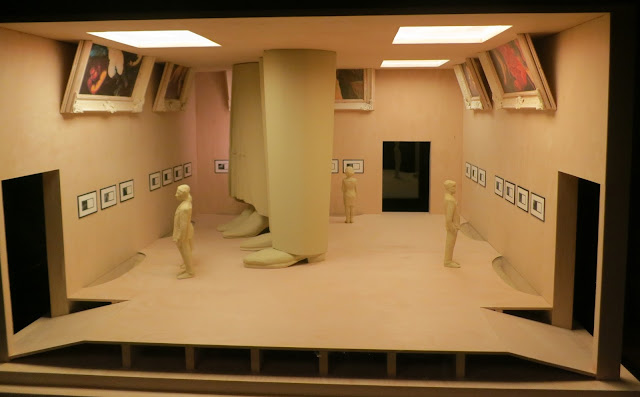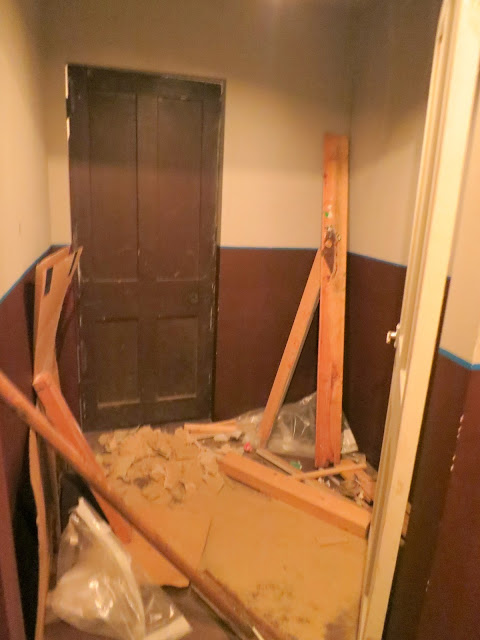Ilya and Emilia Kabakov, Not Everyone Will Be Taken Into the Future,
at Tate Modern.
This exhibition was delightful and great fun. Unfortunately, my photographs do not do it justice - some of the galleries were dark, and the existing light not conducive to photographs.
The Kabakovs are widely known as pioneers of installation art. They began their artistic partnership in the late 1980s and have produced a prolific output of immersive installations and other conceptual works addressing ideas of utopia, dreams and fear, to reflect on the universal human condition. Furthermore, their work tells the dark history of Russia since the 1917 revolution.
Artists in the Soviet Union were obliged to follow the officially approved style, Socialist Realism. Wanting to retain his independence, Ilya supported himself as a children's book illustrator from 1955 to 1987, while continuing to make his own paintings and drawings. His early works explore the possibility of drawing and painting as conceptual media. Having chosen not to be a state-approved fine artist, he worked clandestinely. Sourcing materials was a challenge and many of his early paintings are rendered on plywood, or Masonite, a type of hardboard. The use of these cheap materials emphasises ideas rather than craftsmanship, and sets Ilya's art firmly apart from the official Soviet artists.
Emilia Lekach trained as a classical pianist in Irkutsk and studied Spanish language and literature in Moscow before emigrating to the USA in 1973. In 1988 she met Ilya in New York and this is when they began their artistic partnership. They were married in 1992.
Ilya Kabakov, Head with a Balloon, 1965.
Ilya Kabakov, Hand and Ruisdael's Reproduction, 1965
This puzzling combination of visual elements encourages the viewer to consider different ways of looking, whether rooted in Dutch landscape painting, abstraction or surrealist assemblage. It includes a visual pun, as 'to attach one's hand' is a colloquial Russian expression meaning to add one's signature. The composition can also be seen as a window looking onto a real world, represented by the Ruysdael landscape, with the viewer's arm leaning on the windowsill.
Ilya Kabakov, Soccer Player, 1964
Ilya Kabakov, Holiday
The Holiday series is presented as the work of a fictional Socialist Realist artist. According to this story, the original commission for the painting was cancelled and they were put into storage. The fictional artist rediscovered them and decided to reinvigorate them by adding sweet wrappers - an upgrade that fails to improve upon the prosaic images beneath. The work comments on how the criteria of what makes for 'good' art is politically charged and subject to change, but also draws attention to the fate of artists who fall out of institutional favour.
Ilya Kabakov, Holiday

Ilya Kabakov, The Man Who Flew into Space from his Apartment, 1985
This is Ilya's first whole room, or 'total' installation. We were able to peep through the broken door in the photograph, into a tiny apartment.
A carefully choreographed staging of objects, lighting and text. It presents a fictional narrative that takes place in the confines of a communal apartment - a form of domestic residence that emerged during the Soviet Union to deal with the shortage of housing in urban areas. Multiple households were forced to share the same cooking and washing facilities in often cramped conditions. For Ilya, the Soviet Communal apartment is emblematic of the way in which the individual is exhibited and exposed to the gaze of others. The title character of the installation finds a way to escape from this oppressive, everyday reality by launching himself into space by catapult.
The next two installations also take place in the confines of a communal apartment.
When Olga Nicolaevna came to the kitchen in the morning she saw in the corridor numerous pots, pans, and plates, which were flying in the air.
When Olga Yakovlevna went out to get water in the morning, she saw a lot of pots, flying pans and mugs freely fluttering about like birds in the still dark space of the communal corridor, and a few little white people were standing quietly on the brand new flying pot which belong to Igor Subordin from the corner room.
Trousers in the Corner, 1989
I Catch the Little White Men, 1990
The sculptural installations Trousers in the Corner and I Catch the Little White Men both feature minuscule paper cut-out figures. According to Ilya 'these little white men' are inhabitants of a parallel world who can occasionally be glimpsed by human eyes. The tiny figures are just one example of the subversions of perspective and scale that appear throughout the Kabakov's work, perhaps reflecting the ways in which individuals are elevated and forgotten in historical records.

looking closer

model for Where is Our Place? 2002/2017
Where is Our Place? imagines two exhibitions occurring simultaneously within a single art gallery. Old master oil paintings in thick gilt frames can only be partially seen as they ascend into the ceiling. Meanwhile, a display of contemporary works is shown at eye level. There are also two types of viewers - giants and subterranean beings, whose world is just about visible through windows in the floorboards at the edges of the gallery. This reflection on old and new art is also a play on perspective, emphasising that everything appears relative to one's position in the world.
This installation also draws upon the idea of the museum as a site of cultural authority, shaping our understanding of history, art, and society as a whole.
model for The Vertical Opera, 1998/2008
This is the proposed setting for an ambitious opera on the history of Soviet Russia. The Kabakov's concept utilises the vertical space of the structure, which the audience observes from the balconies. Enclosed within architect Frank Lloyd Wright's modernist vision, each level of the rotunda stands for a different chapter in this musical opera: Ante-Revolution, Revolution, Soviet Times, Perestroika and Post-Perestroika.
detail
detail
Three Nights, 1989
The limits of perception are explored in Three Nights. The three large paintings all relate to the theme of night, whether it be a starry sky or a nocturnal insect. However, they are placed behind a large screen, allowing only a partial view of each work. We had to look through monoculars which are directed at small apertures through which magnified images of little white men can be seen.
This was the title of a 1983 essay about Kazimir Malevich which Ilya wrote in 1983. He imagines Malevich as a charismatic visionary, leading his people upwards into the future. He then remembers his art school where the most deserving pupils were selected to go to the Young Pioneer camp, while the rest were left behind. Ilya reflects that some artists will go forward and become part of the history of art, but many others will be forgotten.
In this installation of an eerie underground station, produced by Ilya and Emilia, a train is already leaving the platform, carrying all of those selected to be part of the future. Discarded canvases bring to mind all of the artists abandoned to obscurity, whether they have fallen out of favour with a political regime or simply become unfashionable. As the art world is so focused on keeping up with the present moment, the Kabakovs ask: 'What will happen to these works tomorrow?'
Under the Snow, 2004
Fragmentary images of parades and heroic soldiers are visible among swathes of white suggesting a historical past buried beneath the blank surface of the present day.
A dark entrance leads to an endless corridor in the form of a maze

Labyrinth (My Mother's Album), 1990
one of Ilya's few directly autobiographical installations. Resembling the décor of a communal apartment building, the walls are lined with
photographs taken by Ilya's uncle, and a memoir by his mother. The text recounts her struggle to survive and bring p a son during the Soviet era.
The corridors curve in a double spiral, fist leading into the centre, then winding out again.
'When I think about that world in which my mother's life passed, what arises in my imagination is a long and semi-dark corridor which is twisted like a labyrinth, where behind each new turn, behind each bend, there is not a bright exit glimmering in the distance, but just the same grubby floor, the same grey, dusty, poorly painted walls illuminated by weak, 40-watt light bulbs'.
Model for Inscriptions on the Wall (Reichstag), 1998/2000
In 1945 Soviet soldiers seized the Reichstag, the former German parliament building. They covered the walls with Cyrillic markings, writing their names, their hometowns, expressions of their hopes and feelings, and their hatred for fascism. More than 50 years later, several artists were invited to propose an artistic intervention in the Reichstag. The Kabakov's unrealised plan was to frame and light some of the surviving inscriptions to memorialise those minor players in the historical narrative and bring into view markings that would otherwise remain invisible.
Man Climbing Over the Wall. Model for a sculpture (The Eternal Emigrant), 1995/2004
Model for How to Meet an Angel, 1998/2002
detail
...
In this last room of the exhibition, the theme of flight appears associated with the possibility of escape - whether from the oppression of the Soviet Union, or more generally from the harsh reality of life. Flight takes the form of an angel, a stateless being that is free from earthly and bureaucratic constraints.
How Can one Change Oneself? 1998
Model for The Three Angels, 2012
detail
How to Meet an Angel, #2, 1997, 2014
The Angel Over the City, 1998
Model for The Five Steps of Life, 2000.2012
looking closer





































No comments:
Post a Comment